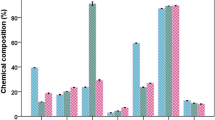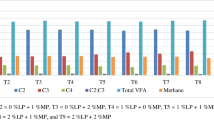Abstract
This study was conducted to evaluate potential of Moringa oleifera seed oil (MOSO) to modulate rumen microflora to mitigate methane (CH4) production in different total mixed rations (TMRs). Three TMRs with different roughage (R) to concentrate (C) ratio were used as substrates (R70:C30, R50:C50 and R30:C70) for in vitro fermentation study using batch culture technique. Results revealed that supplementation of MOSO in different rations with variable roughage to concentrates ratio altered (P < 0.05) CH4 production and fermentation parameters. M. oleifera seed oil at 3 and 4% increased (P < 0.01) microbial protein (MCP) and propionate concentration for all rations but decreased acetate concentration in R70:C30 TMR. Two levels of MOSO (3 and 4%) quadratically increased (P = 0.001) MCP and decreased acetate in R30:C70 while all levels increased propionate. For R30:C70 and R50:C50 rations, MOSO linearly and quadratically decreased (P < 0.001) protozoa and methanogen counts; however, protozoa, methanogens and bacteria were significantly increased in R70:C30 ration without any change in fungal counts. Supplementation of higher level of MOSO (4%) in high roughage ration (R70:C30) showed negative effects on diversity (Shannon index) and evenness of bacterial species as compared to control and lower oil level. Moreover, it also decreased Firmicutes to Bacteroidetes ratio in high roughage rations more obviously at lower levels. Moringa oil also stimulated Prevotella in both high and low roughages diets that indicates its potential to mediate rumen acidosis. Conclusively, MOSO enhanced fermentation kinetics and decreased CH4 production through effective modulation of rumen microbiome.



Similar content being viewed by others
Availability of Data and Materials
Raw sequence data related to this study were submitted in NCBI SRA database with SRA Accession No. SRR10072455 available at https://www.ncbi.nlm.nih.gov/sra.
References
Haque MN (2018) Dietary manipulation: a sustainable way to mitigate methane emissions from ruminants. J Anim Sci Technol 60(1):15
Gomaa AS, Kholif AE, Kholif AM, Salama R, El-Alamy HA, Olafadehan OA (2018) Sunflower oil and Nannochloropsis oculata microalgae as sources of unsaturated fatty acids for mitigation of methane production and enhancing diets’ nutritive value. J Agric Food Chem 66(8):1751–1759
Kholif AE, Elghandour MMY, Salem AZ, Barbabosa A, Márquez O, Odongo N (2017) The effects of three total mixed rations with different concentrate to maize silage ratios and different levels of microalgae Chlorella vulgaris on in vitro total gas, methane and carbon dioxide production. J Agric Sci 155(3):494–507
Kholif AE, Gouda GA, Olafadehan O, Abdo MM (2018) Effects of replacement of Moringa oleifera for berseem clover in the diets of Nubian goats on feed utilisation, and milk yield, composition and fatty acid profile. Animal 12(5):964–972
Naziroğlu M, Güler T, Yüce A (2002) Effect of vitamin E on ruminal fermentation in vitro. J Vet Med A 49(5):251–255
Lins TDA, Terry S, Silva R, Pereira L, Jancewicz L, He M, Wang Y, McAllister T, Chaves A (2019) Effects of the inclusion of Moringa oleifera seed on rumen fermentation and methane production in a beef cattle diet using the rumen simulation technique (Rusitec). Animal 13(2):283–291
Szumacher-Strabel M, Martin S, Potkanski A, Cieslak A, Kowalczyk J (2004) Changes in fermentation processes as the effect of vegetable oil supplementation in in vitro studies. J Anim Feed Sci 13:215–218
Weatherburn M (1967) Phenol-hypochlorite reaction for determination of ammonia. Anal Chem (Wash) 39(8):971–974
Makkar H, Sharma O, Dawra R, Negi S (1982) Simple determination of microbial protein in rumen liquor. J Dairy Sci 65(11):2170–2173
Qin W (1982) Determination of rumen volatile fatty acids by means of gas chromatography. J Nanjing Agric Univ 4:110–116
Yu Z, Morrison M (2004) Improved extraction of PCR-quality community DNA from digesta and fecal samples. Biotechniques 36(5):808–812
Denman SE, McSweeney CS (2006) Development of a real-time PCR assay for monitoring anaerobic fungal and cellulolytic bacterial populations within the rumen. FEMS Microbiol Ecol 58(3):572–582
Sylvester JT, Karnati SK, Yu Z, Morrison M, Firkins JL (2004) Development of an assay to quantify rumen ciliate protozoal biomass in cows using real-time PCR. J Nutr 134(12):3378–3384
Denman SE, Tomkins NW, McSweeney CS (2007) Quantitation and diversity analysis of ruminal methanogenic populations in response to the antimethanogenic compound bromochloromethane. FEMS Microbiol Ecol 62(3):313–322
AOAC (1997) Official methods of analysis, 16th edn. Association of Official Analytical Chemists, Washington, DC
Van Soest PV, Robertson JB, Lewis BA (1991) Methods for dietary fiber, neutral detergent fiber, and nonstarch polysaccharides in relation to animal nutrition. J Dairy Sci 74(10):3583–3597
Caporaso JG, Kuczynski J, Stombaugh J, Bittinger K, Bushman FD, Costello EK, Fierer N, Pena AG, Goodrich JK, Gordon JI (2010) QIIME allows analysis of high-throughput community sequencing data. Nat Methods 7(5):335
Soliva C, Kreuzer M, Foidl N, Foidl G, Machmüller A, Hess H (2005) Feeding value of whole and extracted Moringa oleifera leaves for ruminants and their effects on ruminal fermentation in vitro. Anim Feed Sci Technol 118(1–2):47–62
García-González R, López S, Fernández M, González JS (2008) Dose–response effects of Rheum officinale root and Frangula alnus bark on ruminal methane production in vitro. Anim Feed Sci Technol 145(1–4):319–334
McIntosh F, Williams P, Losa R, Wallace R, Beever D, Newbold C (2003) Effects of essential oils on ruminal microorganisms and their protein metabolism. Appl Environ Microbiol 69(8):5011–5014
Dey A, Paul S, Pandey P, Rathore R (2014) Potential of Moringa oleifera leaves in modulating in vitro methanogenesis and fermentation of wheat straw in buffalo. Indian J Anim Sci 84(5):533–538
Wang M, Wang R, Janssen P, Zhang X, Sun X, Pacheco D, Tan Z (2016) Sampling procedure for the measurement of dissolved hydrogen and volatile fatty acids in the rumen of dairy cows. J Anim Sci 94(3):1159–1169
Ferreira PMP, Farias DF, Oliveira JTdA, Carvalho AdFU (2008) Moringa oleifera: bioactive compounds and nutritional potential. Revista de Nutrição 21(4):431–437
Tekeli A, Celik L, Kutlu HR (2007) Plant extracts; a new rumen moderator in ruminant diets. Tekirdağ Ziraat Fakültesi Dergisi 4(1):71–79
Jouany J-P (1346S) Effect of rumen protozoa on nitrogen utilization by ruminants. J Nutr 126:1335S–1346S
Lee S, Lee H, Oh Y (2000) Methane production from enteric fermentation in ruminants. Asian-Australas J Anim Sci 13(Special iss.):171–181
Benchaar C, McAllister T, Chouinard P (2008) Digestion, ruminal fermentation, ciliate protozoal populations, and milk production from dairy cows fed cinnamaldehyde, quebracho condensed tannin, or Yucca schidigera saponin extracts. J Dairy Sci 91(12):4765–4777
Zhou M, Chung YH, Beauchemin K, Holtshausen L, Oba M, McAllister T, Guan L (2011) Relationship between rumen methanogens and methane production in dairy cows fed diets supplemented with a feed enzyme additive. J Appl Microbiol 111(5):1148–1158
Klappenbach JA, Saxman PR, Cole JR, Schmidt TM (2001) rrndb: the ribosomal RNA operon copy number database. Nucleic Acids Res 29(1):181–184
Li Y, Zhang G-N, Xu H-J, Zhou S, Dou X-J, Lin C, Zhang X-Y, Zhao H-B, Zhang Y-G (2019) Effects of replacing alfalfa hay with Moringa oleifera leaves and peduncles on intake, digestibility, and rumen fermentation in dairy cows. Livest Sci 220:211–216
Premi M, Sharma H (2017) Effect of extraction conditions on the bioactive compounds from Moringa oleifera (PKM 1) seeds and their identification using LC–MS. J Food Meas Charact 11(1):213–225
Kholif AE, Morsy TA, Gouda GA, Anele UY, Galyean ML (2016) Effect of feeding diets with processed Moringa oleifera meal as protein source in lactating Anglo-Nubian goats. Anim Feed Sci Technol 217:45–55
Jones G, McAllister T, Muir A, Cheng K-J (1994) Effects of sainfoin (Onobrychis viciifolia Scop.) condensed tannins on growth and proteolysis by four strains of ruminal bacteria. Appl Environ Microbiol 60(4):1374–1378
Wallace RJ, Chaudhary LC, McKain N, McEwan NR, Richardson AJ, Vercoe PE, Walker ND, Paillard D (2006) Clostridium proteoclasticum: a ruminal bacterium that forms stearic acid from linoleic acid. FEMS Microbiol Lett 265(2):195–201
Hoffmann E, Muetzel S, Becker K (2003) Effects of Moringa oleifera seed extract on rumen fermentation in vitro. Arch Anim Nutr 57(1):65–81
Makkar H (2003) Effects and fate of tannins in ruminant animals, adaptation to tannins, and strategies to overcome detrimental effects of feeding tannin-rich feeds. Small Rumin Res 49(3):241–256
Makkar H, Becker K (2000) Beneficial effects of saponins on animal production. In: Oleszek W, Marston A (eds) Saponins in food, feedstuffs and medicinal plants. Springer, Dordrecht, pp 281–286
Shanks OC, Kelty CA, Archibeque S, Jenkins M, Newton RJ, McLellan SL, Huse SM, Sogin ML (2011) Community structures of fecal bacteria in cattle from different animal feeding operations. Appl Environ Microbiol 77(9):2992–3001
Mohammadzadeh H, Yáñez-Ruiz DR, Martínez-Fernandez G, Abecia L (2014) Molecular comparative assessment of the microbial ecosystem in rumen and faeces of goats fed alfalfa hay alone or combined with oats. Anaerobe 29:52–58
Dong L, Zhang T, Diao Q (2019) Effect of dietary supplementation of Moringa oleifera on the production performance and fecal methanogenic community of lactating dairy cows. Animals 9(5):262
Indugu N, Vecchiarelli B, Baker LD, Ferguson JD, Vanamala JK, Pitta DW (2017) Comparison of rumen bacterial communities in dairy herds of different production. BMC Microbiol 17(1):190
Li R, Teng Z, Lang C, Zhou H, Zhong W, Ban Z, Yan X, Yang H, Farouk MH, Lou Y (2019) Effect of different forage-to-concentrate ratios on ruminal bacterial structure and real-time methane production in sheep. PLoS ONE 14(5):e0214777
Jami E, White BA, Mizrahi I (2014) Potential role of the bovine rumen microbiome in modulating milk composition and feed efficiency. PLoS ONE 9(1):e85423
Jobim ML, Santos RCV, dos Santos Alves CF, Oliveira RM, Mostardeiro CP, Sagrillo MR, de Souza Filho OC, Garcia LFM, Manica-Cattani MF, Ribeiro EE (2014) Antimicrobial activity of Amazon Astrocaryum aculeatum extracts and its association to oxidative metabolism. Microbiol Res 169(4):314–323
Oliveira Ramos AF, Terry SA, Holman DB, Breves G, Pereira LGR, e Silva M, Guimarães A, Chaves AV (2018) Tucumã oil shifted ruminal fermentation, reducing methane production and altering the microbiome but decreased substrate digestibility within a RUSITEC fed a mixed hay–concentrate diet. Front Microbiol 9:1647
Acknowledgements
Dr. Hossam Ebeid gratefully acknowledges the scholarship from Guangxi Science and Technology Department on Receiving ASEAN Talented Young Scientist (Guangxi) Program launched by Ministry of Science and Technology of China (MOST of China) and B&R Countries in accordance with the Circular No. 2018-2. Authors are also thankful to Dr. Hamdy Zahran at Fats and Oils Department, Food Industries and Nutrition Division, National Research Centre, Egypt for his help regarding analysis of fatty acids.
Funding
This study was supported by National Key Research and Development Program of China (2016YFD0500507 and 2018YFD0501600), the National Natural Science Foundation of China (N0.31560649) and the Guangxi Natural Science Foundation (2018GXNSFAA281162).
Author information
Authors and Affiliations
Contributions
Conceptualization, HME; Data curation, HME; Formal analysis, HME and FH; Statistical analysis, AEK; Funding acquisition, YC; Investigation, HME and FH; Methodology, HME, LM and FH; Project administration, HME and LM; Resources, LM, PL, LX and YC; Supervision, YC; Validation, YC; Writing—original draft, AEK and HME; Writing—review & editing, AEK, FH, HME and YC.
Corresponding author
Ethics declarations
Conflict of interest
All authors declare that there are no present or potential conflicts of interest among authors and other people or organizations that could inappropriately bias their work.
Ethical Approval
All animal procedures were approved by Ethics Committee of Guangxi Buffalo Research Institute, Chinese Academy of Agriculture Sciences, China.
Informed Consent
All authors read and approved the manuscript for publication in Current Microbiology Journal.
Additional information
Publisher's Note
Springer Nature remains neutral with regard to jurisdictional claims in published maps and institutional affiliations.
Electronic supplementary material
Below is the link to the electronic supplementary material.
Rights and permissions
About this article
Cite this article
Ebeid, H.M., Mengwei, L., Kholif, A.E. et al. Moringa Oleifera Oil Modulates Rumen Microflora to Mediate In Vitro Fermentation Kinetics and Methanogenesis in Total Mix Rations. Curr Microbiol 77, 1271–1282 (2020). https://doi.org/10.1007/s00284-020-01935-2
Received:
Accepted:
Published:
Issue Date:
DOI: https://doi.org/10.1007/s00284-020-01935-2




